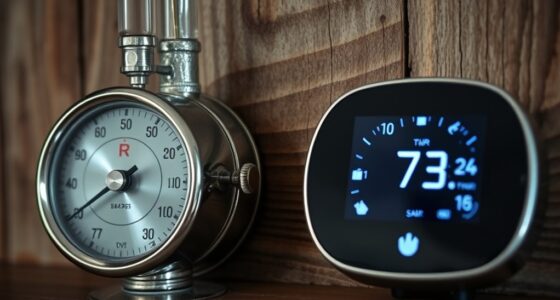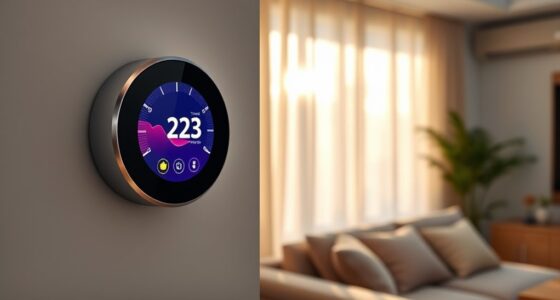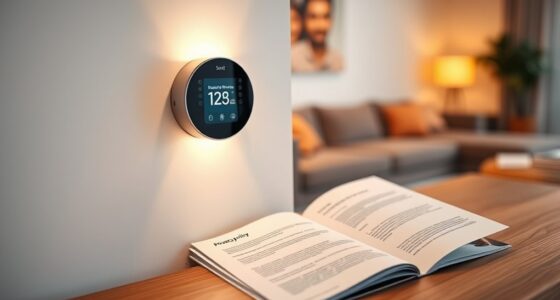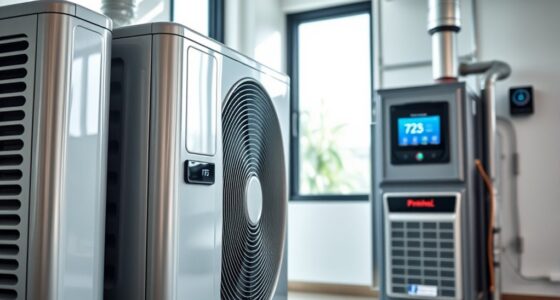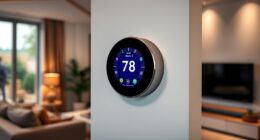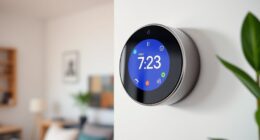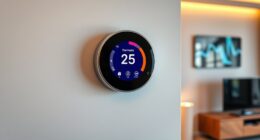Smart thermostats detect occupancy and motion using a combination of sensors that monitor movement, sound, temperature, and light levels. Many utilize ultrasonic detection technology to improve accuracy and responsiveness. These sensors work together to identify whether a space is in use, helping the thermostat adjust settings accordingly. Proper calibration and regular maintenance guarantee reliable detection, reducing false alarms. If you want to learn how these innovative sensors work together to make your home smarter, keep exploring the details.
Key Takeaways
- Smart thermostats use sensors that detect motion, temperature changes, sound, and light levels to determine occupancy.
- Ultrasonic detection technology enhances accuracy by sensing movement through sound wave reflections.
- Multiple sensors work together to assess whether a space is actively in use, reducing false occupancy signals.
- Regular calibration and maintenance of sensors ensure reliable detection and prevent false alarms or missed activity.
- Data collected from sensors is encrypted and managed to protect user privacy while enabling effective occupancy detection.
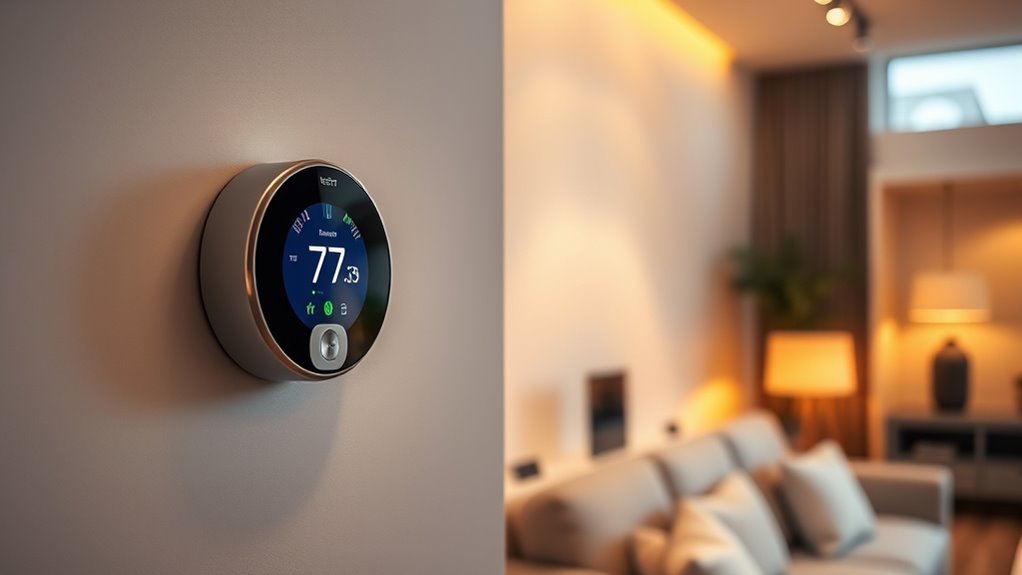
Smart thermostats are transforming home climate control by detecting when rooms are occupied, allowing you to save energy and improve comfort effortlessly. They do this through a variety of sensors that monitor motion, temperature changes, and sometimes even sound or light levels. These sensors work together to determine whether a space is in use, adjusting your heating or cooling accordingly. To guarantee these systems operate accurately, sensor calibration is essential. Proper calibration means the sensors are fine-tuned to recognize true occupancy signals and distinguish them from false alarms, like pets moving or shadows shifting. When calibration is off, your thermostat might misinterpret activity, leading to unnecessary energy use or discomfort. Regularly checking and recalibrating sensors helps maintain efficiency and reliability, so your system responds precisely to room occupancy. Additionally, advancements in sensor technology, such as ultrasonic detection, further enhance occupancy sensing accuracy and responsiveness. Incorporating sensor maintenance into your routine can prevent drift in sensor sensitivity over time, ensuring consistent performance. At the same time, user privacy is a vital consideration with smart thermostats. Since these devices collect data on your home’s activity patterns, you want to feel confident that your information is secure. Manufacturers implement privacy protections, such as encryption and anonymization, to safeguard your data. Many smart thermostats also give you control over what information is shared and stored, allowing you to customize privacy settings. Understanding how your device manages sensor data helps you balance convenience with privacy. For instance, you might choose to limit data collection to essential occupancy detection, rather than continuous monitoring, to reduce privacy concerns. Being aware of these options ensures you stay in control of your personal information while enjoying the benefits of intelligent climate control.
Frequently Asked Questions
Can Smart Thermostats Distinguish Between Pets and Humans?
Smart thermostats can sometimes distinguish between pets and humans through pet detection features, but they’re not perfect. They use motion sensors and temperature changes to identify occupancy, which can lead to false occupancy detection if pets move around. While some advanced models attempt to minimize false alarms, you should still verify settings to avoid unnecessary heating or cooling adjustments caused by pet activity.
How Quickly Do Smart Thermostats Respond to Occupancy Changes?
You might worry about delayed responses, but smart thermostats respond quickly thanks to advanced occupancy algorithms and sensor accuracy. They detect occupancy changes within minutes, sometimes even seconds, ensuring your home stays comfortable without wasting energy. These algorithms process sensor data efficiently, minimizing lag. So, you can trust that your thermostat adapts swiftly to your presence or absence, providing seamless climate control and energy savings.
Do Smart Thermostats Use Cameras to Detect Presence?
Smart thermostats generally don’t use cameras to detect presence. Instead, they rely on camera technology in other smart home devices or motion sensors to sense activity. Motion sensors detect movement in a room, helping the thermostat adjust temperature accordingly. Cameras, if used, are usually part of security systems rather than the thermostat itself, ensuring privacy while still enabling occupancy detection through other methods.
Can Occupancy Detection Be Overridden Manually?
Imagine holding the reins of your home’s comfort. Yes, you can override occupancy detection manually, giving you full control when needed. Most smart thermostats let you adjust settings directly, bypassing sensor accuracy for your peace of mind. Whether you want to keep your system on despite no motion or turn it off temporarily, manual control guarantees you’re the master of your environment, no matter what the sensors detect.
Are There Privacy Concerns With Occupancy Sensors?
You might worry about privacy implications with occupancy sensors, but manufacturers prioritize data security to protect your information. These sensors typically collect minimal data, often anonymized, to optimize comfort and energy savings. However, it’s wise to review privacy policies and settings. By understanding how your smart thermostat manages data, you can enjoy its benefits while ensuring your privacy remains secure and your data protected.
Conclusion
Think of your smart thermostat as a vigilant lighthouse keeper, constantly scanning the horizon for signs of life. When it detects your presence or motion, it lights up, guiding your home to comfort and efficiency. Without it, your house is like a ship lost at sea—blind to when you’re home or away. With this technology, your home becomes a well-orchestrated symphony, responding seamlessly to your every move, making life simpler and more energy-smart.


